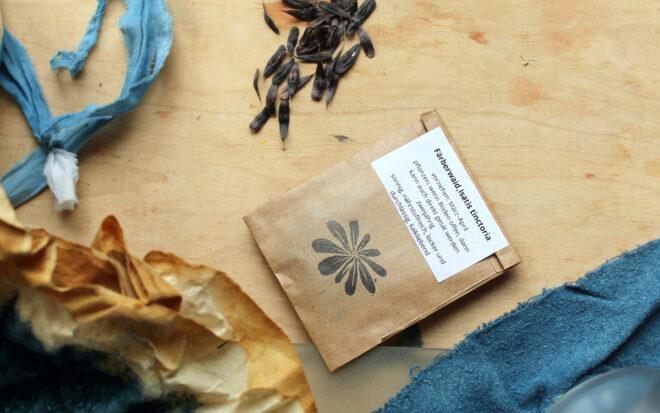Your basket is currently empty!

Short + sweet: Woad
Woad, or Isatis tinctoria
Woad has a long history in Germany, especially in Thuringia, where it provided work and prosperity. Likewise in other regions of Central Europe, for example the southwest of France. Nevertheless, woad does not originate from Central Europe. Woad was cultivated by humans very early on and accompanied them as a dyeing plant - in Europe this can be traced back to the iron age !
'Short + sweet' is a series of shorter posts: a quick look at a plant, in history, botany and dye pot.
These compact blogposts were inspired by questions I receive from time to time on Instagram . Maybe you'd like to follow along there?
Woad seeds
The seeds are quite large dark shimmering pods which contain the actual small seeds. The pods contain germination-inhibiting substances. Soaking them before sowing (or opening the pods and taking out the mini seed) speeds up germination, and increases the number of seeds that sprout.

Dyeing with woad
The green leaves contain the indigo precursor. The fresh leaves can be used to make a vat - dyeing like this is fun, but also temperamental, especially if you forgo harsh ingredients for the vat! I dyed delicate baby blue tones with a fresh woad vat in my last attempt, and then unexpectedly a soft lilac purple.
In the past, 'woad balls' were formed from the leaves, small balls in which the leaves fermented/dried. Thus, the dye was stored, transported and used for vats.
Färben in der Küpe
*Dye baths for so-called vat dyes are called a vat. In the plant world, as far as I know, this only applies to plants that contain indigo - such as woad and dyer's knotweed. The vat contains ingredients that make the water-insoluble indigo dye soluble.
This requires a fairly alkaline pH (usually between 9 and 12, depending on the recipe) and a reducing agent that removes oxygen from the indigo molecule, making it ready for binding.
This can be done by fermentation, with ingredients like slaked lime + certain fruit sugars, overripe fruits or citrus peels (in that case the pectin replaces fruit sugar) and in the textile industry conventionally it is done with faster acting substances like sodium hydrosulfite, which pollutes e.g. waste water.
Instead of dyeing with the fresh leaves I mostly prefer to extract the pigment from the leaves and dry that for storage. That's what I have most experience with and how I can process small harvests. Apart from that, I like to experiment with woad in bundle dyeing.

But most of all I love when the woad is in bloom in its 2nd year! I'm already looking forward to it again. Woad flowers earlier than the other dye plants in my garden, but after the fruit trees are through blooming. The inflorescence with many small, bright yellow individual flowers are attracting countless insects, and I really enjoy watching this every year.


Wenn du noch mehr über Färberpflanzen lesen möchtest, oder Tipps und Tricks zu Aussaat und Pflege suchst, dann schau mal, ob mein 'Farbe ernten' (german only) was für dich ist!

Passend zum Thema hab ich mal ein Mitbringsel aus Thüringen bekommen. Ein kleines Büchlein: Färberwaid. Blaues Gold aus Thüringen von Georg Schwedt.

Leave a Reply